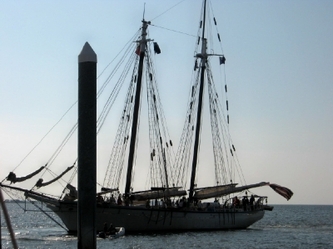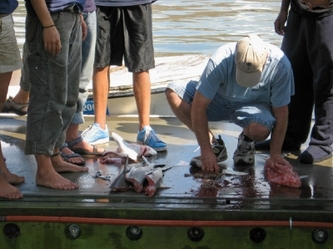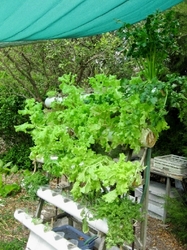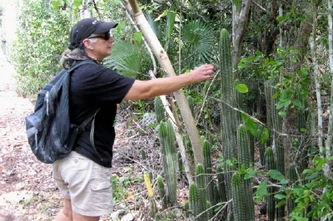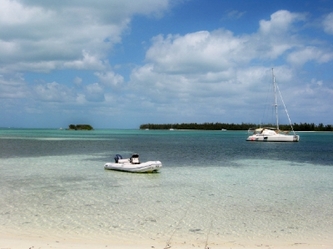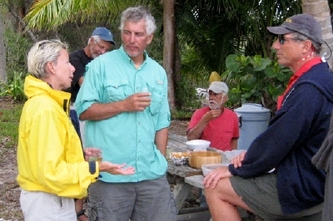
We’re back in the US, here in Charleston, SC. Two years ago, on our first trip south, it took us a week to get here once we left the Bahamas. Last year, it took 2 weeks to journey north from Marathon to Charleston. This year, we did it in a little over 2 days. Not bad.
Timing is Everything
The line of boats heading north past Manjack Cay seemed endless. As we watched them go, heading toward a departure point for the trip back to the US, we kept asking ourselves: should we go to?
Weather guru Chris Parker had identified a window to cross the Gulf Stream on Sunday, April 19th to Monday, April 20th. But it would be a short one, so the furthest we would be able to go was probably Cape Canaveral. We had wanted to go further north – maybe to Fernandina Beach or, preferably, Charleston. But that would take 2 to 3 days. So, we decided to let this window go and wait for the next one. Still the boats kept moving – for 3 days. On Thursday night, many of them stayed with us at Manjack – over 30 of them. It was enough to make us question our decision to wait. But, as we thought about traveling with this many boats – crowded anchorages, jockeying at bridge openings -- we began to feel more confident in letting this opportunity go.
Within a couple of days, we began to hear the first indication that our patience was going to pay out. As Chris was advising some of his customers on passages north, he started to indicate a longer period of settled weather was coming our way. As his forecasts became more certain, they also became more promising. We were going to see days of calm weather north of the Bahamas. He was telling boats preparing for long passages that if they had ever considered going around Hatteras on the outside, but had been too put off by its notorious foul weather, they should consider doing it in this window. Wow! This looked like it.
Chris’ only caution about the weather was the possibility of too little wind, making it largely a motoring trip. So, we made some calculations and determined we could make it as far as Charleston, even if we had to motor the whole way, but we would want to re-fuel at some point along the way. We considered this for a bit. Our fuel fill is on the transom on our stern. Dave usually stands on the swim platform when we are re-fueling at a dock or from jerry jugs. That was not going to happen in the ocean. But his primary purpose for standing there is to monitor how full the tank is in order to avoid an overflow. We wouldn’t need to worry about that in the ocean, since we would just be adding fuel for a margin of safety. That would just mean that one or both of us would need position ourselves with the jerry jugs on the stern and hold the siphon in the fuel fill. Not something we would want to do in rough ocean conditions, but if it was so calm that we didn’t have enough wind to sail, then it should be a relatively simple process to execute in those conditions. We decided to go for it.
So, we began making the boat ready and then positioned ourselves at Great Sale Cay for a Thursday morning (April 23rd) crossing. Dave used the hookah system to clean what growth had accumulated on the bottom of Orion and the dinghy. He changed the zinc, which had held up well for the 3 months since it was changed in Florida. Cathy organized food for what could be more than 3 days at sea, making meals and snacks that could be served quickly and easily. We stowed loose items, pulled out charts for the states, got the routes planned and loaded to the chartplotter, and hauled and strapped down the dinghy and motor. We moved gradually north and west, dodging weather as we travelled from Manjack to Powell to Crab and finally Great Sale Cay.
As we pulled into Great Sale Cay, we had only 4 other boats as company. We were hoping to find traveling companions for the trip to Charleston, but this didn’t look promising. After chatting with those in the anchorage, we appeared to be the only ones with such lofty ambitions. By sunset however, there were closer to 20 boats in the anchorage. We tried once more and connected with 2 other boats: one (Grateful Lattitudes) heading to Brunswick, GA or maybe Charleston and the other (Hawkeye) heading to Charleston, but wanting to wait for more wind until Friday. We decided to head out at first light with those heading to Brunswick, sharing their company as long as it would last. After having 2 restless nights dealing with passing storms the nights before, we both collapsed into bed early to get some much-needed sleep as we prepared for the long trip ahead.
Timing is Everything
The line of boats heading north past Manjack Cay seemed endless. As we watched them go, heading toward a departure point for the trip back to the US, we kept asking ourselves: should we go to?
Weather guru Chris Parker had identified a window to cross the Gulf Stream on Sunday, April 19th to Monday, April 20th. But it would be a short one, so the furthest we would be able to go was probably Cape Canaveral. We had wanted to go further north – maybe to Fernandina Beach or, preferably, Charleston. But that would take 2 to 3 days. So, we decided to let this window go and wait for the next one. Still the boats kept moving – for 3 days. On Thursday night, many of them stayed with us at Manjack – over 30 of them. It was enough to make us question our decision to wait. But, as we thought about traveling with this many boats – crowded anchorages, jockeying at bridge openings -- we began to feel more confident in letting this opportunity go.
Within a couple of days, we began to hear the first indication that our patience was going to pay out. As Chris was advising some of his customers on passages north, he started to indicate a longer period of settled weather was coming our way. As his forecasts became more certain, they also became more promising. We were going to see days of calm weather north of the Bahamas. He was telling boats preparing for long passages that if they had ever considered going around Hatteras on the outside, but had been too put off by its notorious foul weather, they should consider doing it in this window. Wow! This looked like it.
Chris’ only caution about the weather was the possibility of too little wind, making it largely a motoring trip. So, we made some calculations and determined we could make it as far as Charleston, even if we had to motor the whole way, but we would want to re-fuel at some point along the way. We considered this for a bit. Our fuel fill is on the transom on our stern. Dave usually stands on the swim platform when we are re-fueling at a dock or from jerry jugs. That was not going to happen in the ocean. But his primary purpose for standing there is to monitor how full the tank is in order to avoid an overflow. We wouldn’t need to worry about that in the ocean, since we would just be adding fuel for a margin of safety. That would just mean that one or both of us would need position ourselves with the jerry jugs on the stern and hold the siphon in the fuel fill. Not something we would want to do in rough ocean conditions, but if it was so calm that we didn’t have enough wind to sail, then it should be a relatively simple process to execute in those conditions. We decided to go for it.
So, we began making the boat ready and then positioned ourselves at Great Sale Cay for a Thursday morning (April 23rd) crossing. Dave used the hookah system to clean what growth had accumulated on the bottom of Orion and the dinghy. He changed the zinc, which had held up well for the 3 months since it was changed in Florida. Cathy organized food for what could be more than 3 days at sea, making meals and snacks that could be served quickly and easily. We stowed loose items, pulled out charts for the states, got the routes planned and loaded to the chartplotter, and hauled and strapped down the dinghy and motor. We moved gradually north and west, dodging weather as we travelled from Manjack to Powell to Crab and finally Great Sale Cay.
As we pulled into Great Sale Cay, we had only 4 other boats as company. We were hoping to find traveling companions for the trip to Charleston, but this didn’t look promising. After chatting with those in the anchorage, we appeared to be the only ones with such lofty ambitions. By sunset however, there were closer to 20 boats in the anchorage. We tried once more and connected with 2 other boats: one (Grateful Lattitudes) heading to Brunswick, GA or maybe Charleston and the other (Hawkeye) heading to Charleston, but wanting to wait for more wind until Friday. We decided to head out at first light with those heading to Brunswick, sharing their company as long as it would last. After having 2 restless nights dealing with passing storms the nights before, we both collapsed into bed early to get some much-needed sleep as we prepared for the long trip ahead.
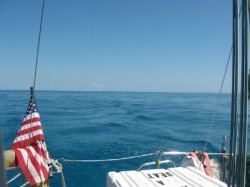
The Little Bahama Bank is flat calm as we approach Mantanilla shoal.
Charleston Bound
We were the first boat underway the next morning, just ahead of Grateful Lattitudes and Exodus, but our lead didn’t last long. Unlike our traveling companions, we decided to sail in the light winds and save fuel, but after only a few hours, we furled the sails and powered up. It would be over 24 hours before we would try again.
We were in luck that Grateful Attitudes was a sponsoring vessel for Chris Parker, allowing him to obtain the Gulf Stream coordinates, which we eagerly took down. Dave plotted a route to take maximum advantage of the current in the Gulf Stream for our trip north. Once we left the Little Bahama Bank, near sunset on Thursday, we would benefit from the north-flowing stream for almost 30 hours, at times reach 10 knots over ground, even though our rpms were only about 2400.
We were the first boat underway the next morning, just ahead of Grateful Lattitudes and Exodus, but our lead didn’t last long. Unlike our traveling companions, we decided to sail in the light winds and save fuel, but after only a few hours, we furled the sails and powered up. It would be over 24 hours before we would try again.
We were in luck that Grateful Attitudes was a sponsoring vessel for Chris Parker, allowing him to obtain the Gulf Stream coordinates, which we eagerly took down. Dave plotted a route to take maximum advantage of the current in the Gulf Stream for our trip north. Once we left the Little Bahama Bank, near sunset on Thursday, we would benefit from the north-flowing stream for almost 30 hours, at times reach 10 knots over ground, even though our rpms were only about 2400.
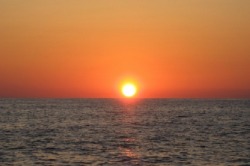
Sunset as we enter the Gulf Stream
The wind shifted a bit during the 56-hour run, but it was mostly from the southeast when it had any strength at all. That kept the swells small and manageable. We did try to sail again the next evening, but the wind was too much behind us and too light to be effective. We took opportunities Friday morning and again Friday evening to re-fuel, adding 15 gallons to keep up the margin of safety for the remainder of the trip.
Being so far out (at times 100 miles off-shore), we had less traffic and more sea life than our earlier trips outside in the ocean. We saw pilot whales, dolphins breaching, and amazingly, a hitchhiker in the form of goldfinch, who joined us for about 20 hours, until we neared Charleston. For a wild thing, he had no fear of us and quickly perched on our shoulder or head when we were still for a few minutes. Amazing.
Being so far out (at times 100 miles off-shore), we had less traffic and more sea life than our earlier trips outside in the ocean. We saw pilot whales, dolphins breaching, and amazingly, a hitchhiker in the form of goldfinch, who joined us for about 20 hours, until we neared Charleston. For a wild thing, he had no fear of us and quickly perched on our shoulder or head when we were still for a few minutes. Amazing.

Dave and hitchhiker
But by Saturday morning, we were approaching the Charleston sea buoy, slowing for the first time in 3 days as the ebbing current pushed against us on the long ride up the inlet. That wasn’t the only change. We were entering Charleston harbor on a beautiful Saturday afternoon. It seemed that everyone who owned a boat was on the water. There were sailboat races, fishing boats, cigarette boats, even a couple of cruise ships. The only good news was that the big commercial vessels were not on the move. As we approached the City Marina dock (our first time staying on the Ashley River), we were almost side struck by another sailboat heading into the same marina. Do we have a target painted on our side?
We pulled into the dock just ahead of a departing cruise ship and breathed a sigh of relief once the lines were secure. Customs cleared us in on the dock about an hour later and we were officially back in the US. Legal and everything.
We had never traveled so far in one run or been so far offshore, but were grateful for the company of other cruisers and the good forecast that held for the length of the trip. It was a great trip, which we can only hope will be repeated the next time we venture out into the ocean.
We pulled into the dock just ahead of a departing cruise ship and breathed a sigh of relief once the lines were secure. Customs cleared us in on the dock about an hour later and we were officially back in the US. Legal and everything.
We had never traveled so far in one run or been so far offshore, but were grateful for the company of other cruisers and the good forecast that held for the length of the trip. It was a great trip, which we can only hope will be repeated the next time we venture out into the ocean.

Dave stuidies the bus routes
Boat Stuff
It’s been a while since we’ve done much “boat stuff”, but now that we’re tied to a dock (we moved to the Maritime Center the day after we arrived in Charleston), we are taking advantage of the access to shore to get a few things done. Putting over 50 hours on the engine brought us up to an oil change cycle. Once we finished that, Dave decided to change the Racor fuel filter and drain the bowl. Unfortunately, the o-ring in the drain fill split, so he couldn’t re-fill the bowl until we had a replacement. In the process of finding a place to order the o-ring, he located a valve that he could install in the drain fill, making it easier to drain in the future. He was able to order it on Sunday and install it on Tuesday. Not too bad. He also ordered a spare parts kit for the Racor from Bayshore Marine, which contained all the the o-rings and gaskets for the unit should the same thing happen again.
The other big project on the boat is the batteries. Dave proceeded to charge and equalize them, but was becoming convinced that one of the house batteries was worse than the others and drawing it down. He collected some statistics about the batteries and sent them off to Trojan to get their assessment. They confirmed that replacing, at a minimum, the one battery would prevent the others from being dragged down by it.
Cathy spent her time doing wash, pulling the seat covers off all of the cushions and airing out any that smelled of mildew (which wasn’t many). She re-sorted the V-berth, cleaned all the canvas and glass and anything that had exposed to saltwater over the winter. Hopefully, this would prevent moisture collecting in it over the summer and minimize any mildew problems.
We, of course, did the usual re-provisioning in Charleston, making trips to Harris Teeter and taking the bus to Sam’s Club, Wal-mart and Boater’s World.
It’s been a while since we’ve done much “boat stuff”, but now that we’re tied to a dock (we moved to the Maritime Center the day after we arrived in Charleston), we are taking advantage of the access to shore to get a few things done. Putting over 50 hours on the engine brought us up to an oil change cycle. Once we finished that, Dave decided to change the Racor fuel filter and drain the bowl. Unfortunately, the o-ring in the drain fill split, so he couldn’t re-fill the bowl until we had a replacement. In the process of finding a place to order the o-ring, he located a valve that he could install in the drain fill, making it easier to drain in the future. He was able to order it on Sunday and install it on Tuesday. Not too bad. He also ordered a spare parts kit for the Racor from Bayshore Marine, which contained all the the o-rings and gaskets for the unit should the same thing happen again.
The other big project on the boat is the batteries. Dave proceeded to charge and equalize them, but was becoming convinced that one of the house batteries was worse than the others and drawing it down. He collected some statistics about the batteries and sent them off to Trojan to get their assessment. They confirmed that replacing, at a minimum, the one battery would prevent the others from being dragged down by it.
Cathy spent her time doing wash, pulling the seat covers off all of the cushions and airing out any that smelled of mildew (which wasn’t many). She re-sorted the V-berth, cleaned all the canvas and glass and anything that had exposed to saltwater over the winter. Hopefully, this would prevent moisture collecting in it over the summer and minimize any mildew problems.
We, of course, did the usual re-provisioning in Charleston, making trips to Harris Teeter and taking the bus to Sam’s Club, Wal-mart and Boater’s World.
Enjoying Charleston

Liz and Pat from Cats Paw
Our boat projects haven’t kept us from enjoying Charleston while we’re here. We got to meet in person several boats we traveled with, having dinner the first night with Jill and Wayne on Born to Cruise and having a visit from Pat and Liz on Cats Paw. Later in our stay, Pride, Tradition and Perserverance2 arrived in the Maritime Center for a few days.
We’ve managed to get in several walks downtown, which is especially beautiful this time of year as flowers bloom from every window box and planting by the historic homes. And, of course, there is the on-going show of boats coming and going at the Maritime Center, from the grand training schooner, Harvey Gamage, to the more humble, but no less dramatic Outward Bound boats, which docked under oar power. We were even treated to a shark cleaning lesson by a local boater, giving a talk to some local high school students.
We’ve managed to get in several walks downtown, which is especially beautiful this time of year as flowers bloom from every window box and planting by the historic homes. And, of course, there is the on-going show of boats coming and going at the Maritime Center, from the grand training schooner, Harvey Gamage, to the more humble, but no less dramatic Outward Bound boats, which docked under oar power. We were even treated to a shark cleaning lesson by a local boater, giving a talk to some local high school students.

Sunset over sailboat at Manjack Cay
Parting Shots - Manjack Cay
While we waited for weather in the Bahamas, we took the time to explore more of Manjack Cay, hiking north along the Sea of Abaco, following the trails to tiny Coconut Tree Beach and then the cove that defined the northern anchorage. On our way up the trails, we visited with Bill and Leslie on shore a bit and offered to help out in a small way, by hanging a trail sign as we hiked. With the weather a bit warmer, we swam some beside the boat, diving down to collect a few sea biscuits and sea urchin shells, that were covering the bottom.
We also got to meet a number of other boaters in the harbor that were joining us in waiting for better crossing weather, as we gathered on the beach for a get-together Friday night before we left.
We say goodbye to the these lovely waters with fond memories and hopes to come back to see more of them.
While we waited for weather in the Bahamas, we took the time to explore more of Manjack Cay, hiking north along the Sea of Abaco, following the trails to tiny Coconut Tree Beach and then the cove that defined the northern anchorage. On our way up the trails, we visited with Bill and Leslie on shore a bit and offered to help out in a small way, by hanging a trail sign as we hiked. With the weather a bit warmer, we swam some beside the boat, diving down to collect a few sea biscuits and sea urchin shells, that were covering the bottom.
We also got to meet a number of other boaters in the harbor that were joining us in waiting for better crossing weather, as we gathered on the beach for a get-together Friday night before we left.
We say goodbye to the these lovely waters with fond memories and hopes to come back to see more of them.


